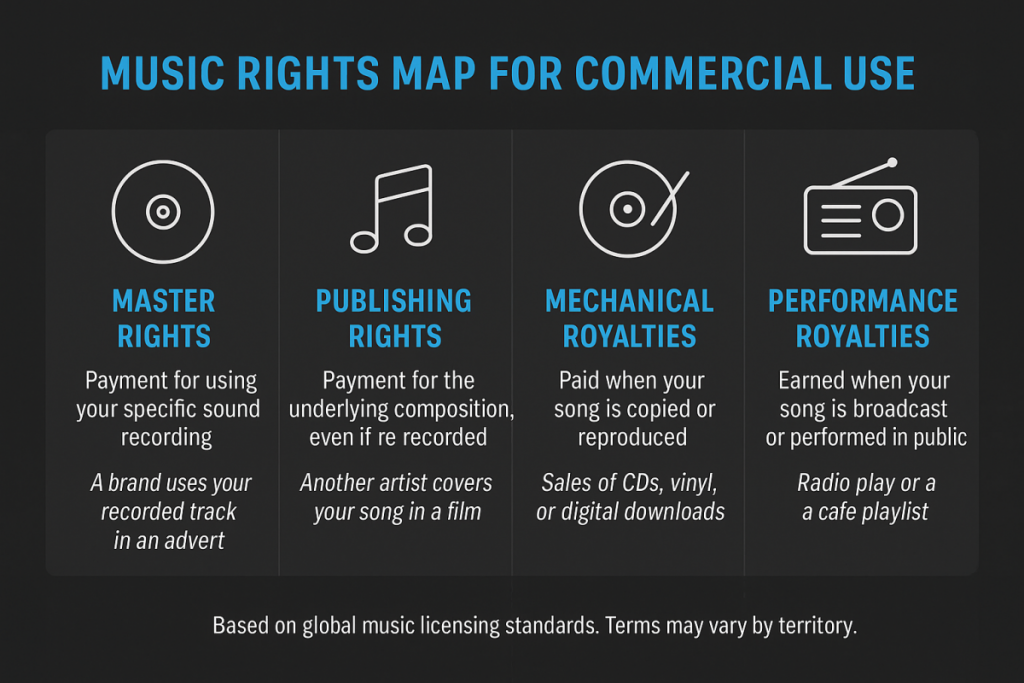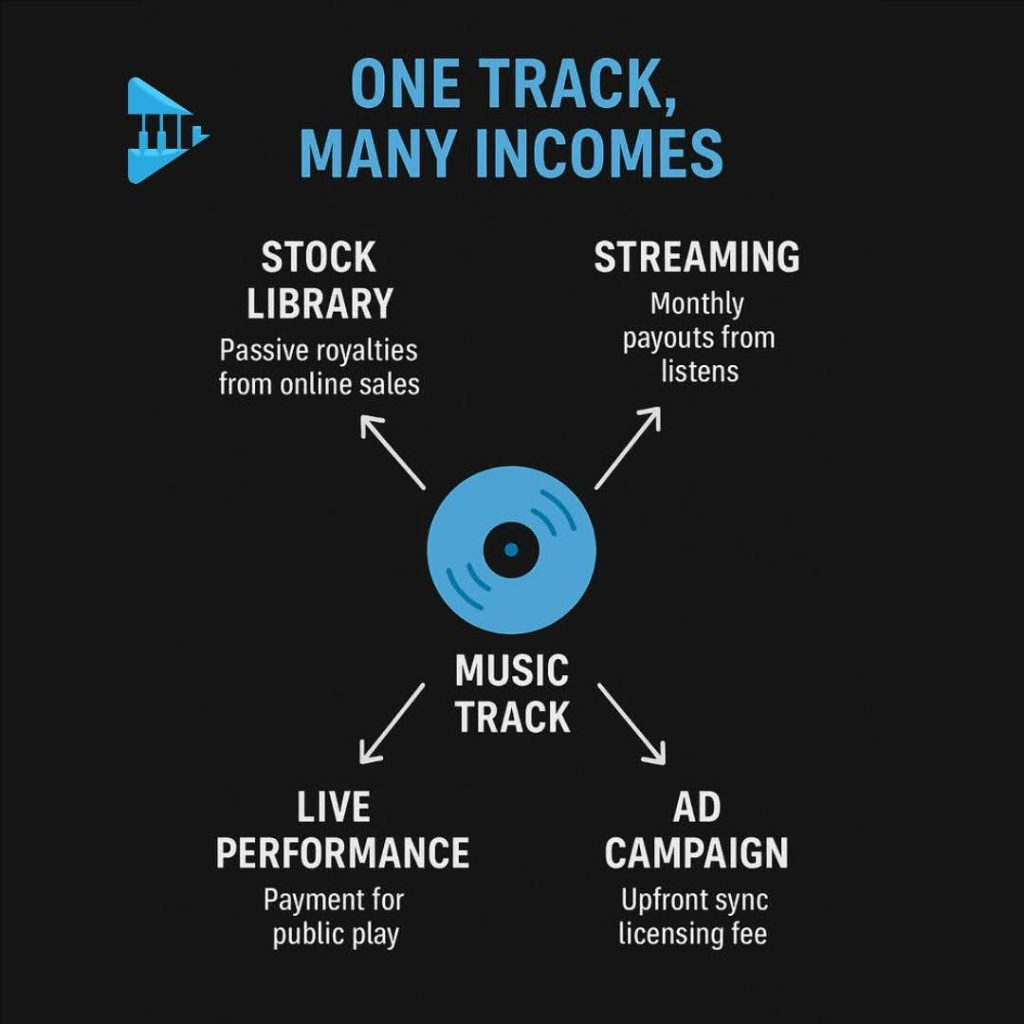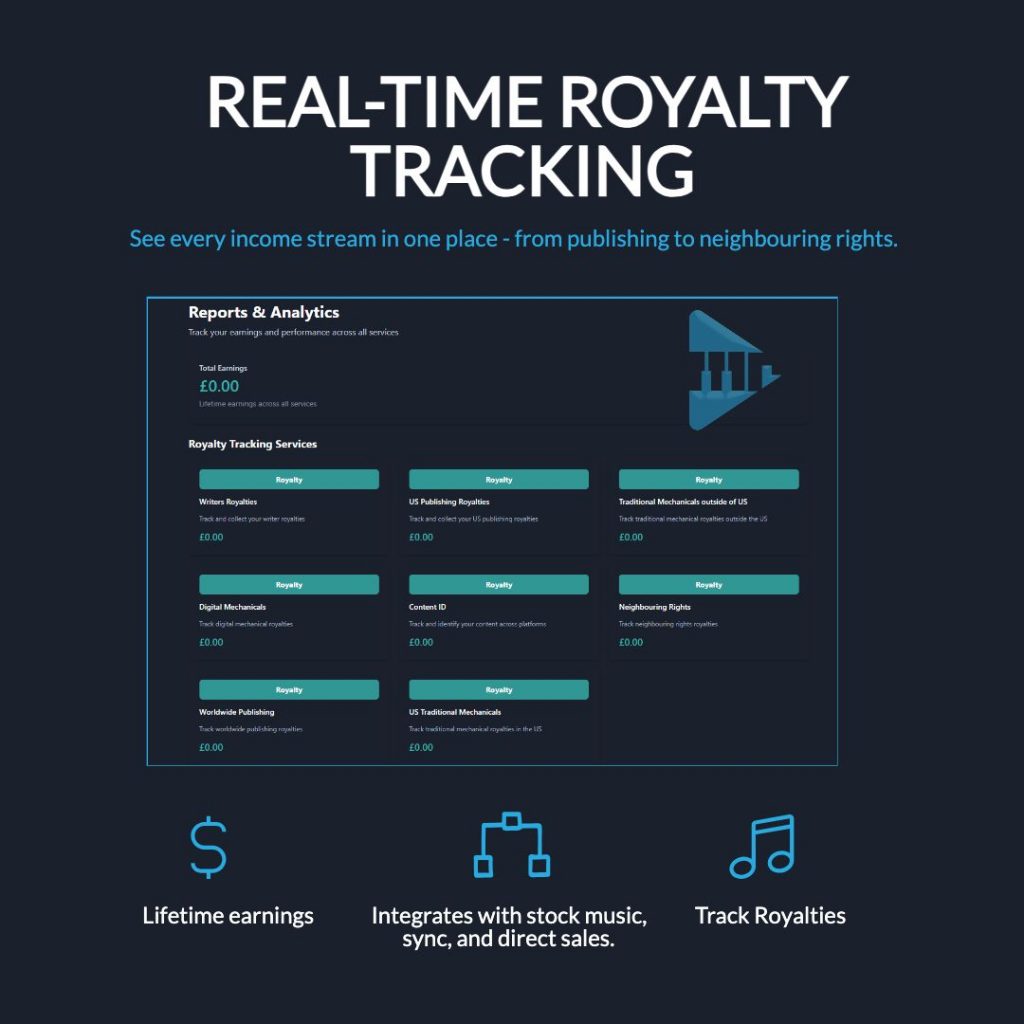Table of Contents
ToggleQuick Answer: Best Ways for Selling Your Music for Commercial Use
TL;DR (Quick Answer): Selling Music for Commercial Use
Selling your music for commercial use means going beyond streaming to license your tracks across ads, apps, video content, and more. This guide shows independent artists how to build a catalog, choose the right licensing models, price strategically, and protect their royalties, all while staying in full control of their rights.
1. Why Selling Music for Commercial Use Matters in 2025
The global recorded music market passed $29.6 billion in 2024, with streaming subscriptions climbing to over 752 million worldwide. Performance rights alone brought in $2.9 billion according to Reuters.
That is not just an industry win for the majors.
As the demand for creative projects grows, so does the need for music. Whether it’s an ad agency, a game studio, an independent filmmaker, or an app developer, they’re all searching for the right track to bring their work to life.
If you can position yourself as that go-to source, you are in the game.
Too many independent musicians assume their only income option is streaming pennies. Selling music for commercial use opens doors to far bigger payouts, often from projects you would never expect.
2. What Counts as “Commercial Use” for Music
Commercial use covers anything where your track is helping to generate money or promote something, from a local café advert to a prime-time TV drama.
Here’s why it matters. Each use triggers different royalties and rights:
- Master rights are the payment for using your actual recording
- Publishing rights are payment for the underlying composition
- Mechanical royalties are paid when your song is copied or reproduced
- Performance royalties come from broadcast or public play
- Neighbouring rights apply to certain plays outside your home territory
I once worked with an artist whose song made it into a streaming series soundtrack. They got a nice upfront fee but missed out on ongoing international royalties because their neighbouring rights were not registered. That is money left on the table.

You can dive deeper into how each royalty type works in our full guide to music royalties.
3. Main Ways to Sell Music for Commercial Use
Before you settle on a platform, stop and decide what kind of license you want to offer. This is more than a formality. The choice can shape how much you earn and how often the income comes in.
Royalty-Free vs Rights-Managed Licensing
In a royalty-free deal, the buyer pays once. They can then use your track under set terms, often in several projects without needing to come back for another license. It’s a fast process and works well for stock music platforms. The trade-off is that the same piece could end up with many different clients.
Rights-managed licensing is different. Here, you agree on very specific terms, such as a three-month advertising campaign or a single TV episode. If they want to use it again, they have to arrange a new license. This model can bring higher fees and gives you more say over how your music is used, though it usually takes more time to arrange.
Some musicians mix both. They use royalty-free sales for steady, repeat income, and reserve rights-managed deals for projects that are worth more. The trick is knowing which tracks work best in which category.
Exclusive vs Non-Exclusive Sales
After you decide on a licensing approach, think about exclusivity. An exclusive sale means one buyer has the only rights to use that track for an agreed period. You usually get a higher upfront fee, but you cannot license it to anyone else until the term ends.
Non-exclusive sales are more flexible. You can license the same track to multiple buyers at the same time. This can create more consistent earnings, even if the upfront payment is smaller. Many artists combine both methods, keeping exclusives for well-paid custom work and using non-exclusive deals for library sales that can run in the background all year.
Think about what works for you. Stock libraries offer wide reach under royalty-free deals. Custom high-value placements deserve rights-managed or exclusive licensing. Most artists use both smartly, based on the track and the audience.
Sell Stock Music Online
Think of stock libraries as music supermarkets. The wider your shelf space, the better your odds. That’s why non-exclusive uploads are powerful – the same track can earn in multiple places at once.
For example, a short acoustic guitar loop uploaded to three different non-exclusive libraries could sell for a YouTube travel vlog, a podcast intro, and a small business ad. Even at modest prices, those small licenses can add up to hundreds in passive income over time.
Do not underestimate metadata. Tracks with vague or lazy tags get buried. Mood, tempo, genre, and usage descriptions can make the difference between a sale in days and a track collecting dust for years.
Here’s our breakdown of the top music selling sites right now and what makes each one worth considering.
Sell Your Music to Other Artists
Some of the best collaborations and licensing deals come from genuine connections. Research artists who need your style of music, reach out with respect, and make sure your demos are ready with rights already secured.
Imagine licensing a custom beat to a rapper for a flat fee, then months later renegotiating when the track gains traction on social media and a brand wants to use it in a campaign. That single sale could multiply its original value without creating new music.
We’ve put together a step-by-step approach for selling music directly to companies and other artists.
Sync Licensing for TV, Film, Ads, and Games
A single sync deal can out-earn a year of streaming. The value isn’t just in the upfront check, it’s in the performance royalties that keep paying over time. I’ve seen modest indie film placements lead to international broadcasts years later, generating steady back-end income.
You can explore our full submission guide for getting your music placed in film and TV.
Direct-to-Fan Sales
Direct sales still work, especially in niche genres with loyal fanbases. Offer exclusive editions, signed merch, or behind-the-scenes content to make your offer more valuable than a standard stream.
If you want a detailed plan for turning online music sales into a reliable income stream, check out our guide.
4. Why a Music Catalog Outperforms One-Off Sales
One track is a gamble. A full catalog is an investment. A producer with 50 well-tagged tracks across libraries, sync agents, and direct sales has a much better shot at consistent income.
For example, an instrumental composer with a well-built catalog could license a single track to an ad campaign for £1,500, even if it had been sitting in their library for years.
If you’re building a broader income strategy around your catalog, this guide breaks it down clearly: How to Sell Music Online and Make Money

5. Check for Royalty Leaks Before They Drain Your Earnings
The most painful loss is money you did not even know you had made. Common leaks I come across:
- Not registering with a PRO is one of the biggest mistakes artists make, so follow our guide to registering your music correctly.
- Skipping neighbouring rights registration
- Leaving YouTube Content ID unused
- Forgetting to withdraw stock library earnings
How Different Music Sales Compare (Typical 2025 Payouts)
| Revenue Stream | Typical Earnings Per Use |
| Streaming (1,000 plays) | £2–£4 |
| Stock Music License | £16–£240 |
| Sync Placement | £100–£1,000+ |
| Direct Fan Sale | £1–£10 per track / £8–£12 per album |
(These ranges reflect common earnings reported by independent artists and platforms. Actual payouts vary by distributor, platform cut, and project terms.)
This is why licensing is where the money is. You don’t need millions of listeners, just the right buyers, in the right places.
6. Pricing Music for Commercial Licensing
Price too low and you undercut your value, too high and you scare off potential buyers.
On stock sites, the sweet spot is usually £16 to £240 per track. Direct sync can range from £100 to £1,000 or more, with exclusive rights commanding higher fees but removing resale opportunities.
More pricing guidance: How Musicians Make Money.
7. Outreach Kits That Actually Work
Different buyers need different things. The goal isn’t to pitch everyone the same folder. It’s to meet them where they are.
- For game developers, offer looping stems and layered tracks that adapt to gameplay. A short demo video showing your track in a mock-up menu or cutscene is often more effective than a playlist.
- For ad agencies, keep it fast and flexible. Provide multiple edit lengths (15, 30, 60 seconds) and note the mood, pace, and style. Mention where it might fit- like lifestyle, fitness, or tech campaigns.
- For indie filmmakers, make delivery simple. Include stems, alt versions, and a clear usage summary. Quick turnaround matters more than a perfect mix.
A solid outreach kit doesn’t just sell a sound. It shows how plug-and-play your track is.
8. Streamline Your Release Workflow
Managing music releases gets messy fast if you don’t have a system. Save yourself time and avoid mistakes by building a repeatable process.
- Tag all metadata before uploading
- Use artwork templates to stay consistent
- Choose one platform to distribute from
- Schedule releases in advance to stay visible
Getting this right once means you won’t need to start from scratch every time. It also helps you keep track of what’s earning and what needs a push.
9. The Cost of Skipping PROs or Content ID
I’ve seen artists lose money simply because they didn’t activate basic royalty tools. If your track gets used or goes viral and you’re not registered, you don’t get paid.
Some key examples:
- No PRO registration means missing out on broadcast royalties
- No Content ID means others can monetize your music on YouTube
- Forgetting metadata means plays might not even be tracked
If you’re not collecting, someone else is. Fix this now with our music protection guide.
10. How Melody Rights Fits Into Selling Music for Commercial Use
Melody Rights is built for artists who want more than streams. It helps you license your tracks, track every royalty type, and keep ownership of your work.
What it does:
- Delivers your music to sync agents, libraries, and stock platforms
- Tracks writer, publisher, mechanical, and neighbouring royalties
- Works alongside your current distributor
- Keeps everything in one dashboard, easy to manage
This lets you stay focused on creating while knowing your music is being properly placed and paid.

11. Your Next Step
Your music isn’t just content. It’s an asset. One that can earn for years when set up right.
Start by learning what each royalty means, then build a catalog that’s easy to license and hard to ignore.
If you’re not sure where to begin, this guide lays out the full income strategy: How to Sell Music Online and Make Money
FAQ
Stock licensing is when you put your music into a library where buyers can grab it for a set price. In many cases, that price covers multiple uses, which makes it quick for them and hands-off for you.
Sync licensing, on the other hand, is when someone picks your track for a particular project- maybe a scene in a movie, a TV commercial, or a game trailer. These placements usually come with a higher upfront payment, and there’s often the bonus of collecting royalties each time the project airs or is streamed. You can dive deeper into the difference between master and publishing royalties in sync deals here.
What is the difference between sync and stock licensing?
Stock licensing is when you put your music into a library where buyers can grab it for a set price. In many cases, that price covers multiple uses, which makes it quick for them and hands-off for you.
Sync licensing, on the other hand, is when someone picks your track for a particular project- maybe a scene in a movie, a TV commercial, or a game trailer. These placements usually come with a higher upfront payment, and there’s often the bonus of collecting royalties each time the project airs or is streamed. You can dive deeper into the difference between master and publishing royalties in sync deals here.



